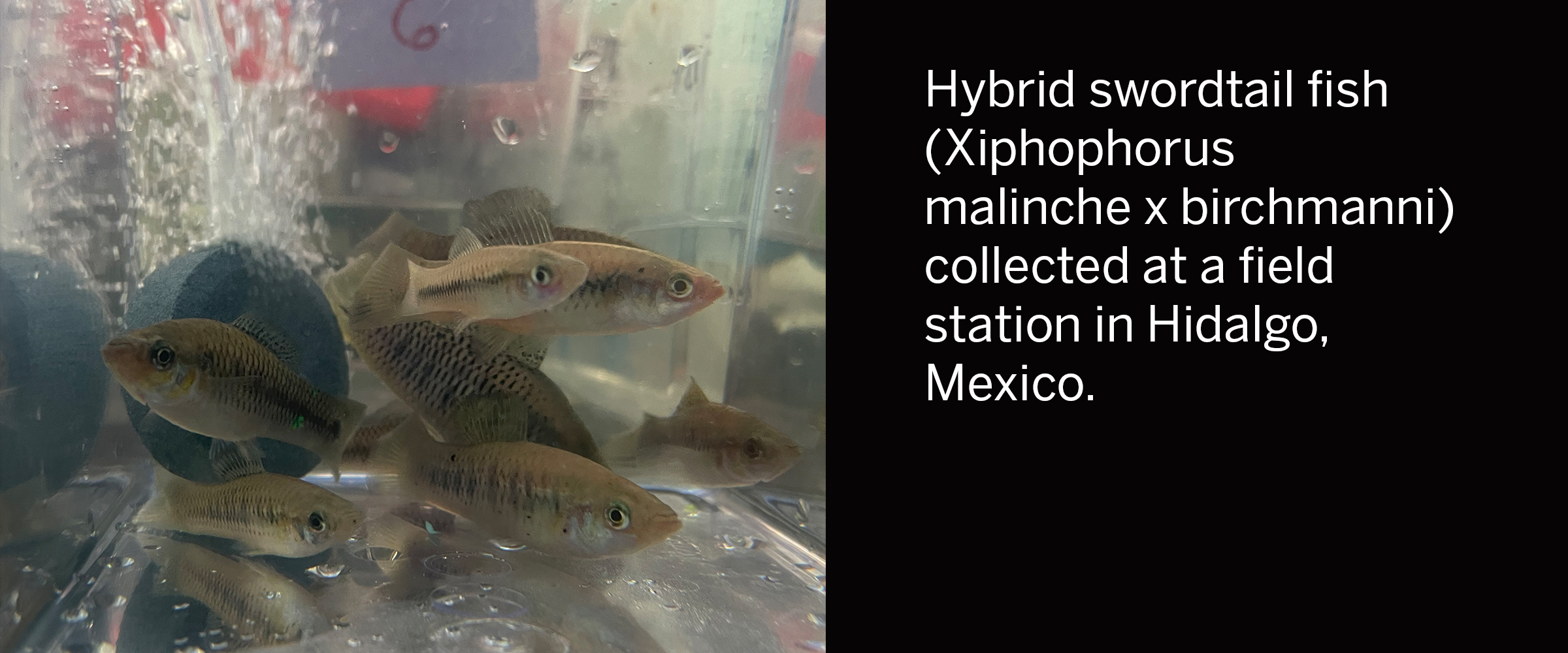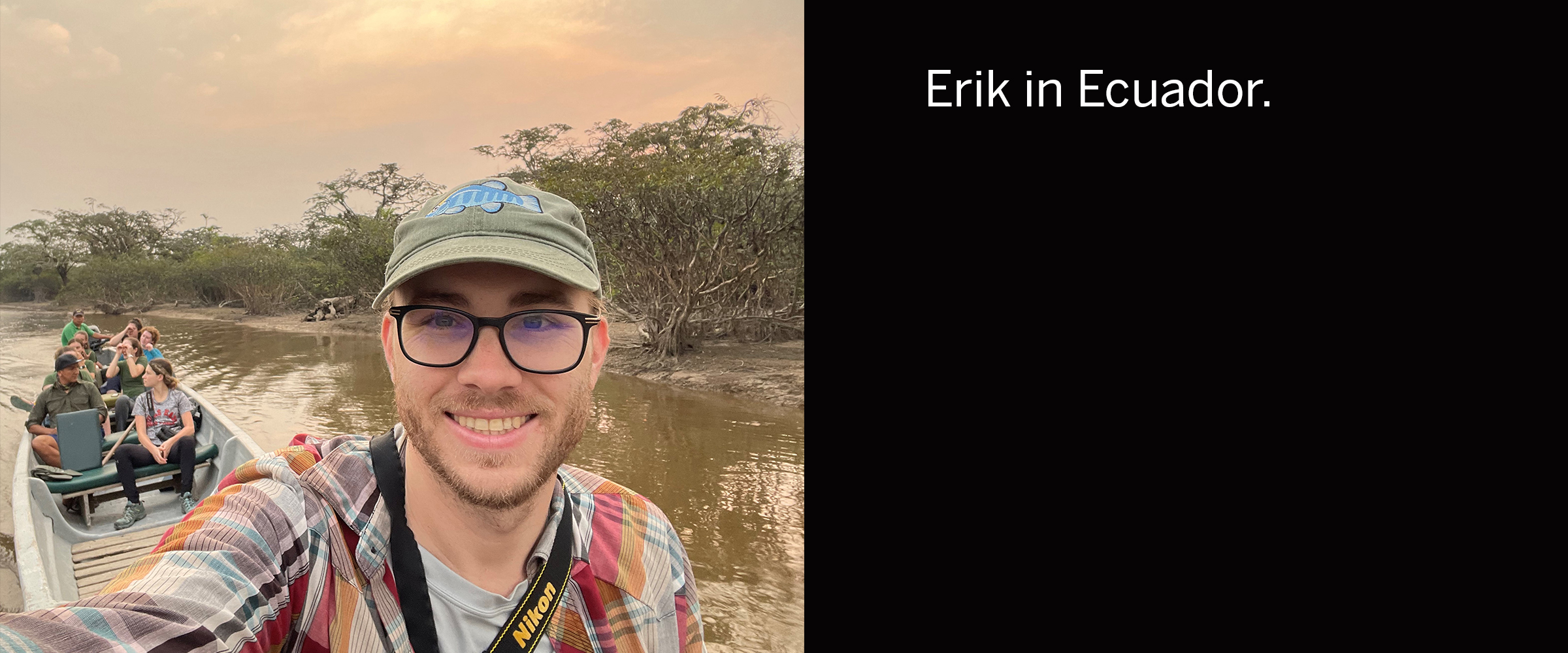
Erik Iverson is one of our 2022 Stengl-Wyer Fellows. Erik studies the influence of mitochondrial genetics and physiology on many aspects of biodiversity and conservation. His research interests and studies have taken him to very diverse places across the globe. In this blog, he talks about his work in these places, his research goals, and how "mitonuclear interactions" work.
Tell us where you came from before UT, and what you studied then?
I'm originally from the San Francisco Bay Area, but I attended Tulane University in New Orleans, Louisiana, for undergrad. While there I pursued any field research opportunity I could get into. I ended up working with Jordan Karubian, a behavioral ecologist who studied birds, and I was able to study seed dispersal in Ecuador and movement ecology in Australia with his lab. I decided to stay at Tulane for a 4+1 master's degree, finishing up a project on bird coloration that I had started with Jordan and turning it into my first publication. After leaving Tulane, I worked on a bunch of projects in various locations--stream surveys in Colorado, agro-ecology in Florida, rainforest conservation in Peru, urban mockingbirds in New Orleans, and avian neuroscience in Atlanta--before deciding to go back to school for my PhD.
You study the influence of mitochondrial genetics and physiology on many aspects of biodiversity and conservation. Can you explain to us how this works?
If you know one thing about mitochondria, it's that they're the powerhouse of the cell--they're the organelles that generate the vast majority of energy our bodies require by breaking down sugars and consuming oxygen. Mitochondria have their own genomes, distinct from the nucleus which contains most of a cell's DNA, because they used to be free-living bacteria before forming a symbiosis with the distant, single-celled ancestors of all multi-cellular life. But their genome is tiny, containing only about 13 protein-coding genes. To replicate and generate energy, mitochondria require nuclear genes, and the proteins from these two distinct genomes either physically join together or work very intimately in close contact. At the molecular level, that means these proteins need to co-evolve to maintain their fit to one another--if a gene from the mitochondrial genome mutates, that protein is going to fit poorly with its counterpart from the nuclear genome, and vice versa. Natural selection maintains the molecular fit that allows for efficient energetics by eliminating poorly-matched combinations or fixing mutations that compensate for mutations in the other genome.

Now comes the interesting part--the implications of these "mitonuclear interactions" for larger evolutionary and ecological processes. Populations evolving in isolation will have uniquely co-adapted mitochondrial and nuclear genomes; they will have fixed different mutations over time, and found different solutions to the problem of maintaining coadaptation. Species adapting to environmental extremes of temperature and oxygen concentration, or to different energetic lifestyles, will face selection either on the mitochondrial genome, nuclear genome, or both. Meanwhile, each genome will impose selection on the other for compatibility. If individuals from two different populations or species come together and hybridize, the mitochondrial genes of one might fit poorly with the nuclear genes of the other and the result is often hybrids with mismatched genes and low fitness. This implies that mitonuclear interactions are a major force in generating reproductive isolation and thus in creating new species, and we have a lot of work ahead to tease out just how the environment, genetic drift, and organismal physiology affect the relationship between mitonuclear genetics and the creation of biodiversity. These mitonuclear interactions also offer us a window into conservation physiology, indicating which differences between species matter for their responses to rising temperatures or acidifying oceans. If we can understand mitonuclear genetics, we can begin to understand what makes species distinct, how they've adapted to their respective environments, and how they'll respond to changes in those conditions. For example, I study related species that are adapted to different elevations; with warming, we expect them all to move up in elevation, but we have no ability to predict which will successfully migrate, which will persist in place, and which will go extinct unless we understand the functional genetics underlying their physiology.

What got you excited to study biodiversity?
For me, it ultimately stems from a love of animals and a love of being outdoors. My earliest memories are of zoos and aquaria, and I grew up hiking and camping. I learned copious facts about the big animals one could hope to see in the wild – bears, elk, mountain lions – but it turns out that you actually mostly see birds and plants when you’re outdoors, and I didn’t know much about those. I started to learn a bit from field guides in high school, but really got into it with a natural history course in college. Once you’re interested in the things you see around you, it’s natural to ask about where they came from – how did we get two totally unrelated butterflies that look exactly the same? Why does this bird occur across country except in California? What happened in the evolutionary past to cause the beautiful patterning of this fish? These questions interested me, but I didn't really think research could be a career until, at one point in high school, I met some field scientists describing new insects in Costa Rica. Prior to that experience, I thought all scientists wore coats and worked in laboratories. The idea that you could make a life out of studying animals in their natural habitats blew me away, and quickly became more enticing to me than being a zookeeper or other animal-oriented work.
Does Texas present a unique situation, challenge or benefit for your research?
Texas is an excellent place to tackle the theoretical issues I study, but a very challenging place to actually collect the necessary data. While most of Texas is hot and flat, there is an extremely important rainfall gradient across the state, from wet in the East to almost bone-dry in the West. There are many pairs of closely related species on opposite sides of this gradient, adapted to different conditions—and sometimes, they meet and hybridize in the middle, which gives us a really powerful genetic tool. Hybridization scrambles the genome and creates a population with varying genes and varying traits—the perfect scenario to test for relationships between genotype and phenotype. Unfortunately, because Texas is 95% privately owned, there are very limited opportunities to actually get outside and sample this genetic diversity. Thankfully, the Texas Eco-labs program creates partnerships between researchers and landowners, facilitating access and discovery in areas without nearby public lands. Through this partnership I’ve been able to gather data for one of my projects, studying a hybrid zone between two Texas bird species just east of Austin.

How will being a Stengl-Wyer Fellow help advance your work?
Being a grad student means trying to juggle your own research, teaching, science communication or advocacy, and maybe your PI’s research as well. Being a Stengl-Wyer Fellow relieves the need to teach or do anyone else’s research and gives me the freedom to pursue multiple projects of my own at once. I study three systems: I work here in Texas on birds called titmice, but I also study two freshwater swordtail fishes from Mexico that hybridize, and I study a series of closely related birds that occur at different elevations in the Peruvian Andes. I have tanks set up in the lab to rear fish and measure their metabolic rates, but I’m also hauling metabolic equipment down to Peru to set it up at field stations in the rainforest. Being able to focus on my research without needing to teach has allowed me to juggle these different tracks of research, and will give me the flexibility to collect more fish from Mexico in the Spring. The support of the Stengl-Wyer program also means so much in terms of allowing us to pursue outreach to the public and science communication. I’ve been able to put together a seminar on tropical ecology this semester, and in April I’ll speak at UT’s Science Under the Stars outreach series. I’ll also be holding a workshop on metabolic ecology for Peruvian researchers in Cusco.
Where do you see your research agenda heading after UT?
My interests are very broad, and I think in any postdoc I do I’d like to learn new skills and work in a new system. My interest in the ecological and evolutionary processes that drive biodiversity will be the same, as will a conservation emphasis, and my time in the lab of Dr. Justin Havird has instilled a type of “mitonuclear thinking” that will probably always influence how I approach problems. But the specific questions and approaches might change a lot; other directions I’m interested in are behavioral genetics, historical and restoration ecology, paleogenomics, and facilitated adaptation. As the situation for biodiversity around the world deteriorates, I’m interested in applying my research more to specific problems and species in need, and I’m considering whether the world might need a dedicated non-profit organization to tackle some of the challenges that climate change poses for mountain species like the birds I study in Peru. I’d like to create an organization like that to translate research into action.



